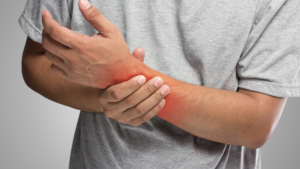Neuropathic pain is a type of pain where the cause is not found in an organ or tissue and can occur in any part of the body. This type is most common in the limbs but can also occur in joints, stomach, or elsewhere. It occurs when nerve cells are damaged or injured, sending signals to be felt as pain, usually through burning, prickling, and tingling sensations. Neuropathic pain can be complicated to treat because it cannot always be easily located like other types of pain.

Things to Know About Neuropathic Pain
Causes of Neuropathic Pain
Nerve Damage or Injury
Neuropathic Pain can occur when the nerve cells are damaged or injured. This may happen as a result of disease or damage to the nerves. It may also occur when the protective covering surrounding the nerve fibers are damaged.
Degeneration
Neuropathic Pain can be caused by degeneration of specific brain cells or spinal cord cells, which send pain signals to the brain. This type of Pain is often due to dementia, Parkinson’s disease, multiple sclerosis, spinal injury, and diabetes.
Compression of the Spinal Cord
Occurs when a person is experiencing a fracture or vertebral compression in the neck, chest, or back. The most common Pain that can occur with this maintenance is referred to as radiculopathy and is characterized by sharp shooting pains that run down the arms, legs, and back.
How to treat neuropathic Pain
The main goal of treating neuropathic Pain is to manage the pain as much as possible and to reduce the side effects of the treatment. People with neuropathic Pain may be referred to standard medication such as:
Opioids
A class of drugs that relieve Pain by suppressing the central nervous system’s response to pain signals. Examples include hydrocodone (Vicodin) and codeine. Medications like these slow the nerves down, making them less sensitive to pain signals.
Anticonvulsant
These medicines constrict the muscles in the brain by reducing abnormal neuron activity or abnormal neuron growth. Examples include carbamazepine (Tegretol), valproic acid (Depakote) and gabapentin (Neurontin).
NSAIDs(Non-steroidal anti-inflammatory drugs)
These painkillers are most commonly used to treat inflammation and swelling, but they also reduce the effects of nerve damage by suppressing the central nervous system’s response to pain signals.
Acupuncture
Acupuncture is a method that involves placing wonderful needles into acupuncture points and in the back to try to curb pain signals from being sent out. Acupuncture can help reduce a person’s sensitivity to Pain by blocking the nerves and nerve pathways.
Transcutaneous electrical nerve stimulation (TENS)
Treatment involves placing electrodes on the skin and pressing them to send signals to particular nerve pathways. TENS can be used as a treatment for Pain that conventional therapies cannot control.
Rehabilitation
When Pain becomes severe and chronic, severe Pain should be treated first. Treatments after that may include rehabilitation therapies. These include physical therapy, which can help improve mobility and strength, cognitive behavioral therapy, which can help to decrease stress and anxiety related to Pain, and psychotherapy, which can also help reduce stress as well as depression or other emotional problems related to the Pain or different multidisciplinary approaches such as educational programs.
Final Thoughts
Neuropathic Pain is a type of Pain that many people suffer from at one point in their lives. In most cases, Pain can be managed with various treatments and medications.
If you suffer from neuropathic pain that conventional treatments cannot control, Progressive Pain Management is here to help you. Fill out the form below to contact our team for further queries.
Peripheral neuropathy is the term used for disorders caused by damage to the body’s peripheral nervous system.
The peripheral nervous system connects nerves from the brain and spinal cord to the rest of the body. Including, but not limited to, the arms, legs and feet, joints, eyes, nose, and even the skin. Peripheral neuropathy is when nerves are damaged and cannot send messages from the brain to other body parts. This damage can cause numbness or pain in these affected areas.

How to Diagnose and Treat Peripheral Neuropathy
Peripheral neuropathy can be separated into two categories: polyneuropathy and mononeuropathy. People most commonly suffer from polyneuropathy.
- Polyneuropathy is when multiple nerves are affected
- Mononeuropathy occurs when only one nerve is affected
How is Peripheral Neuropathy Diagnosed?
There are many symptoms of peripheral neuropathy, such as numbness and tingling, severe sensitivity to touch, lack of coordination, and weakness, to name a few. Because the variety of symptoms is so vast, it can be challenging to diagnose this condition.
A diagnosis program typically includes a review of your medical history, a physical and neurological exam, blood work, and diagnostic testing.
- Medical History. Your doctor will review your medical history and ask questions regarding your symptoms, severity of pain, and what helps relieve the pain. Other factors may include your work environment, anything that triggers the onset of pain, social habits, exposure to toxins, alcohol and tobacco use, and family history of neurological diseases.
- Physical & Neurological Exam. Your doctor will perform a physical exam to look for any diseases that cause nerve damage, such as diabetes or celiac disease. A neurological exam will determine the cause of a neurological disorder and the severity of nerve damage.
- Blood Work. Blood tests are able to test for vitamin deficiencies, organ dysfunction, infections, and any abnormal bodily system activities. These tests can assist the doctor in determining diseases or disorders that cause neuropathic diseases.
Other tests that can be used to test for peripheral neuropathic diseases are imaging tests, nerve and skin biopsies, and nerve function tests.
Types of Treatments Available
Your doctor will recommend a treatment type based on the type of nerve damage, symptoms you display, and the area that is affected. With the guidance of a pain management specialist, you may be able to manage your neuropathic pain and reduce medications. As long as the nerve cell has not died, the consistent and definitive treatment allows for a functional recovery over time.
Treating Underlying Causes
By correcting the underlying cause of your neuropathy, it can many times heal itself and the nerves can recover and regrow. Simple lifestyle changes such as maintaining a healthy weight, eating a nutritious diet, and taking vitamin supplements can improve nerve health. Exercise delivers more blood, oxygen, and nutrients to nerve endings, therefore improving muscle strength and preventing muscular atrophy. Controlling glucose levels has also been shown to reduce neuropathic symptoms and help people with diabetes avoid nerve damage.
If an autoimmune disease or inflammation causes your peripheral neuropathy, symptoms can be controlled by using medications like prednisone. A procedure that involves stripping your blood of immune system cells and antibodies, called plasmapheresis, helps reduce inflammation or subdue immune system activity.
Using Medications
When your peripheral neuropathy is not caused by an underlying disease, medications can be used to minimize symptoms.
- Over-the-Counter Pain Relievers. Medications such as NSAIDs like naproxen, ibuprofen, and aspirin can relieve minor symptoms.
- Topical Treatments. Ointments that contain a substance found in hot peppers has been proven to reduce neuropathic symptoms. Lidocaine patches also provide pain relief, although side effects may include drowsiness, dizziness, or numbness.
- Antidepressants. Antidepressants interfere with the chemical processes in your brain that cause pain. Tricyclic antidepressants like amitriptyline help relieve pain. Drugs like Cymbalta (inhibitor duloxetine) may also ease neuropathic pain. Antidepressants have been known to cause side effects such as nausea, drowsiness, or constipation.
Spinal Cord Stimulation
Spinal cord stimulators (SCS) have been used to treat pain for over 50 years. The implanted device transmits therapeutic electrical signals to provide a therapeutic effect. Neuropathic pain is caused by damaged tissue and nerves. Spinal cord stimulators are surgically placed under the skin. They send mild electrical signals to the spinal cord and nerve fibers. These signals mask pain signals before they can reach the brain.
Therapies to Treat Peripheral Neuropathy
Therapy that helps ease the pain of peripheral neuropathy include:
- Physical Therapy. Muscle weakness and physical disabilities caused by peripheral neuropathic diseases can be reversed under the supervision of a physical therapist and a specialized exercise program. Braces, canes, and walkers may be used to aid treatments.
- TENS. Transcutaneous electrical nerve stimulation delivers a gentle electrical current at various frequencies. Electrodes are placed on the skin over the affected area.
- Plasma exchange. Plasma therapy means your blood is removed, processed to remove antibodies, and returned to your body. This helps suppress the immune system activity that causes inflammation.
Surgery for Peripheral Neuropathy
For some types of neuropathies, surgery is the recommended treatment option. Pinched nerves or conditions that compress nerve roots are generally treated with surgery to free the damaged nerve and allow for proper healing. Mononeuropathy is caused by compression or infections and often requires surgery to release pressure on the nerve.
Polyneuropathies such as diabetic neuropathy is not treated with surgery. If you suffer from polyneuropathy, surgery could potentially make your pain worse. Surgery that involves cutting or injuring the nerve can cause damage to the central nervous system. This has been known to cause phantom pain.
With the evolution of technology, less damaging procedures such as electrical stimulation have replaced surgery to treat peripheral neuropathy. To make an appointment or learn more about peripheral neuropathy, fill out the form below.
Neuropathic pain is a severe burning or shooting pain. This is a condition that is more often chronic. Neuropathic pain is typically caused by severe, progressive nerve disease. This causes damage to various levels of the nervous system; the brain, spinal cord, and peripheral nerves. Also, it can be as a result of infection or damage. It mainly affects the lower back, limbs, and neck. Neuropathic pain can be constant, with the recurrent feeling of burning and shooting accompanied by loss of sensation or numbness.

Causes of Neuropathic Pain
Unfortunately, neuropathic pain is widespread in the US. Researches show that based on best estimates, the prevalence of neuropathic pain among Americans may be between 6.9-10 percent. With chronic pain affecting over 20% of people in the US, neuropathic pain is the leading cause of pain. Populations most likely to experience this kind of pain include manual workers, women, people unable to work, people who are 50 years and above, and rural residents.
Causes Of Neuropathic Pain
The main causes of this form of pain can be categorized into four; disease, infection, injury, and loss of limb.
Disease
A lot of diseases can cause neuropathic pain, but at least 30% of these pain cases result from diabetes. Diabetic peripheral neuropathy affects at least 50% of people who have diabetes.
Other diseases that cause neuropathic pain include:
- Thyroid problems
- Multiple sclerosis
- Fibromyalgia
- Facial nerve issues like trigeminal neuralgia
- Connective tissue disorders
- Liver disease
- Kidney disease
- Alcoholism
- Multiple myeloma
Injury
Even when muscle, tissue, or joint injury has healed or leg, back, or hip problems improve, sometimes damage to the nervous system might not go away. Trauma caused by spinal injuries like spinal cord compression and herniated disc can damage your nerves near the spine. Also, iatrogenic injuries when doctors cut nerves during a surgical operation can cause chronic neuropathic pain.
Infection
Lyme disease, shingles, HIV infection and AIDS, Syphilis, hepatitis B and C, Epstein-Barr virus, leprosy, and diphtheria can also cause neuropathic pain.
Limb Loss
When your hand or arm is amputated, you can suffer neuropathic pain. This is because the nerves near the amputated part may send incorrect signals to the brain, making it feel like the removed limb is in pain.
Neuropathic Pain Treatments
Neuropathic pain treatment aims to know the underlying condition or disease causing the pain and treat it if possible.
The main aim of your pain specialist is to offer pain relief, assist you in maintaining your usual capabilities regardless of the pain, and enhance your life quality. Some of the common treatments include:
Over-The-Counter Medication
NSAIDs like Motrin and Aleve can sometimes be used to treat this kind of pain. Unfortunately, many people don’t find these medicines effective for neuropathic pain, since they do not target the primary source of the pain.
Antidepressant Drugs
These kinds of drugs have shown positive results in treating neuropathic pain symptoms. Two common types of these drugs are prescribed to patients with the following conditions.
- Serotonin-norepinephrine reuptake inhibitors
- Tricyclic antidepressants
These drugs may treat the pain and the symptoms of anxiety or depression caused by chronic pain.
Implantable Device
This is an invasive procedure whereby a surgeon implants a device in your body. Doctors can implant the device in the spine or the brain. After the device is in place, it will send electrical impulses into the spinal cord, brain, or nerves. These impulses may control symptoms and end the irregular nerve signals.
Get Help With Neuropathic Pain Today
Now that you know what neuropathic pain is, its causes and how to treat it, it’s time to see a doctor. Ensure you visit a doctor for the correct diagnosis and a treatment plan. When you get proper treatment, you may find relief and live a high-quality life.
Contact the team at Progressive Pain for help or fill out the form below and start your treatment today.

